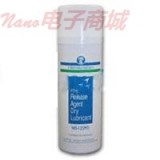
Additional Health Effects: Increased susceptibility to the effects of this material may be observed in persons with pre-existing
disease of the: Central Nervous System, Cardiovascular System.
Pol y-Tetrafluoroeth yiene
Inhalation of PTFE dust may cause generaUzed irritation of the nose, throat, and lungs with cough, difficulty in breathing or shortness
of breath. Inhalation of fluorine compounds released as decomposition products above 290''C (554°F) may cause lung irritation and
pulmonary edema, which require medical treatment. Inhalation of fumes or smoke from overheated or burning Poly-TFE may cause
polymer fume fever, a temporary flu-like illness accompanied by fever, chills, and sometimes cough, of approximately 24 hour in
duration. Repeated episodes of polymer fume fever may cause lung damage.
Isopropyl Alcohol
Short-term overexposure of Isopropyl Alcohol by inhalation may cause irritation of the nose and throat with sneezing, sore throat or
runny nose. Repeated and/or prolonged skin contact with Isopropyl Alcohol may cause defatting of the skin with itching, redness or
rash. There are inconclusive or unverified reports of human sensitization. Contact with the vapor or aerosol may cause eye irritation
with tearing, pain or blurred vision. Ingestion of Isopropyl Alcohol may cause irritation of the digestive tract with stomach pain,
heartbum, nausea, vomiting or diarrhea; however there may be no symptoms at all. Immediate effects of inhalation, ingestion or skin
contact with Isopropyl Alcohol may include non-specific effects such as headache, nausea and weakness; flushing of the face; and low
blood pressure. Repeated and/or prolonged exposure may cause central nervous system depression with dizziness, confusion,
incoordination, drowsiness or unconsciousness. Gross overexposure may cause fatality.
4. FIRST AID MEASURES
Inhalation: Remove patient to fresh air. If not breathing, give artificial respiration. Give oxygen as necessary, if qualified
personnel is available. Get medical attention if necessary.
Eye: Flush with large amounts of water for at least 15 minutes, lifting eyelids until no evidence of the chemical remains. Get
medical attention if necessary.
Skin: Wash skin with water after contact. Wash contaminated clothing before use. Get medical attention if necessary.
Oral: If swallowed, do not induce vomiting, because the hazard of aspirating the material into the lungs is considered greater than
swallowing it. Immediately give 2 glasses of water. Never give anything by mouth to an unconscious person. Get medical
attention.
Notes to Physician: Treatment of exposure should be directed at the control of symptoms and the clinical condition of the
patient.